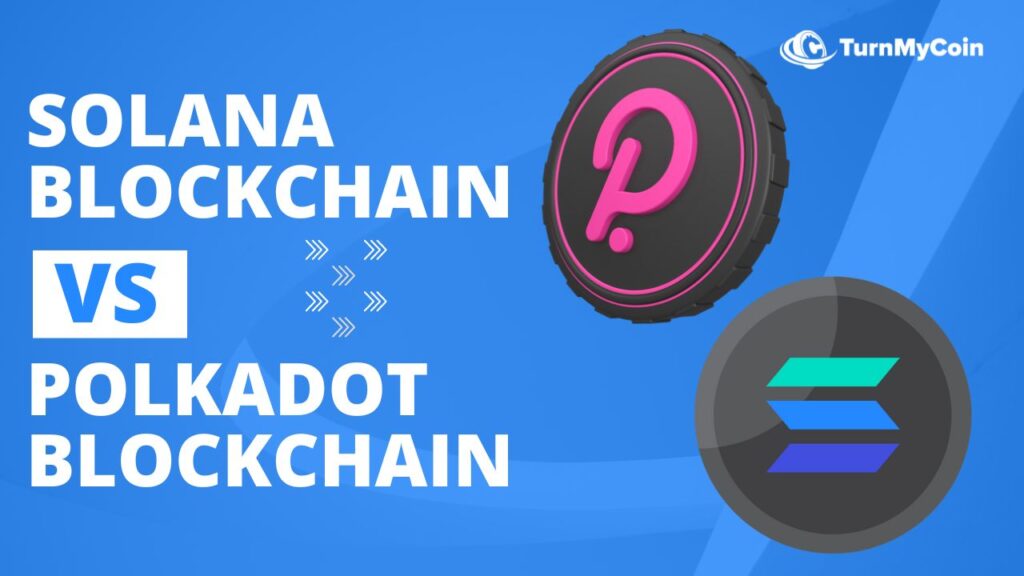Last updated on March 22nd, 2023 at 08:16 am
Introduction
With over 20,000 cryptocurrencies based on nearly 1,000 distinct blockchain platforms, the ever-expanding blockchain sector is crowded.
Such diversity frequently confuses investors, especially when two or more projects appear to be attempting to solve the same problems.
However, there are certain Blockchains that are presently more famous than the others like Ethereum, Binance Smart Chain, Solana, Polkadot, Avalanche, Polygon, Fantom, etc.
In this post, we will analyze the difference between two famous ones: Solana Blockchain vs Polkadot Blockchain.
A short mention about where you can buy these cryptocurrencies. Both Solana & Polkadot are available at:
- 1. About: Polkadot Blockchain Vs Solana Blockchain
- 2. Working: Solana Blockchain Vs Polkadot Blockchain
- 3. Tokenomics: Solana Blockchain vs Polkadot Blockchain
- 4. Evidence of Stake & Evidence of History – Solana Blockchain vs Polkadot Blockchain
- 5. Solana Blockchain vs Polkadot Blockchain – Which is better?
1. About: Polkadot Blockchain Vs Solana Blockchain

What is Polkadot?
Polkadot was born in 2016 when its creator, Gavin Wood, published the Polkadot Whitepaper. Wood is an English computer scientist and one of the most well-known figures in the Bitcoin business.
He is one of Ethereum’s co-founders. He also suggested and played a key part in the design of Solidity, a programming language used for Ethereum smart contracts. Aside from that, Wood worked as a development scientist at Microsoft.
Polkadot seeks to address two of the most pressing concerns in the blockchain industry:
- Sustainability and
- Interoperability.
Many early blockchain networks, like Bitcoin and Ethereum (which will soon switch to the PoS model), used the proof-of-work (PoW) consensus model, which entails consuming huge amounts of computer power and electricity to execute transactions.
They pose a threat to the environment as a result, which needs to be fixed if the industry is to prosper in the future.
Furthermore, the creation of so many blockchain networks in recent years has raised the issue of interoperability. Each blockchain ecosystem has its own technique for dealing with a wide range of issues.
However, practically all of these blockchains operate as closed networks, preventing them from communicating with one another.
Polkadot addressing issue
Polkadot innovation addresses both these issues of sustainability and interoperability.
It is the lowest carbon footprint blockchain because it uses a nominated – PoS (Proof of Stake) consensus methodology to read and approve transactions quickly without the need for significant computational power. The multi-chain topology allows for cross-chain communication while maintaining network security.
Polkadot was created by Gavin Wood’s Parity Technologies, a UK-based software company. The project’s development is overseen by the Web3 Foundation, a non-profit based in Switzerland. Polkadot made a record by raising approximately $145 million via ICO in 2017 and another $100 million in 2019-20.
On May 27, 2020, Polkadot Mainnet was made available. The project is still being developed, though. Polkadot is a smart contract programmable blockchain that focuses on facilitating interoperability between various blockchain networks.
What is Solana?
Anatoly Yakovenko, a Russian computer expert, created Solana. When Yakovenko wrote the Solana Whitepaper in 2017, the project was started. He had previously spent 13 years working for Qualcomm and made substantial contributions to the creation of distributed systems at Mesosphere and Dropbox. Additionally, Yakovenko hired Greg Fitzgerald and Eric Williams, two of his old coworkers from Qualcomm and Dropbox.
The inability of the blockchain to perform numerous transactions while upholding its decentralised nature is the major issue that Solana seeks to address. Only 7 and 30 transactions per second may be validated by the two biggest and most used cryptocurrency blockchains, Bitcoin and Ethereum, respectively.
In comparison, centralized financial institutions like Visa, which can process nearly 24,000 transactions per second, are far slower.
Yakovenko suggested that this issue might be resolved by including an “internal clock” in the blockchain process. By doing this, it is possible to greatly speed up blockchain transactions while maintaining the system’s decentralised nature.
In order to do this, Solana employs a novel consensus mechanism that combines proof-of-history and proof-of-stake models.
The Solana Foundation, a non-profit organisation established in Switzerland, oversees the development of Solana, which was developed by the American software business Solana Labs.
From 2017 to 2020, it raised close to $25 million through multiple ICOs (Initial Coin Offerings). In 2021, it acquired another $340 million from several cryptocurrency venture funding funds.
In March 2020, the Solana Mainnet went live. The network is still in beta; it should be mentioned. Developers (individual or institutional) can program their protocols, services, platforms, and much more on the Solana network because it is a smart contract programmable environment.
Its objective is to displace established markets like Nasdaq and organized financial institutions.
2. Working: Solana Blockchain Vs Polkadot Blockchain
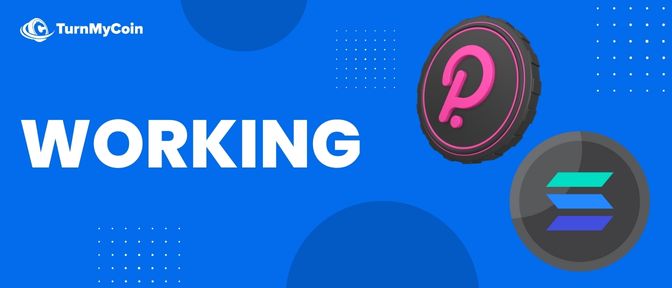
How Polkadot works?
The relay chain and parachains are the two fundamental parts of the complete Polkadot structure. The network as a whole is supported by the relay chain. For consensus and security upkeep, all parachains rely on the relay chain.
All the parachains can be viewed as the relay chain’s branches, with the relay chain serving as the central hub.
The relay chain uses the nominated – PoS consensus mechanism, which functions nearly identically to delegated-PoS (DPoS), to obtain consensus. But according to experts, the former is significantly more effective than the latter.
There are two different kinds of network nodes: validators and nominators. New transactions must first be authenticated by validators before being added to the network. They handle transactions for both parachains and the relay chain.
To become a validator, a node must be chosen by the nodes that nominated it.
According to the Polkadot network’s official site, there are 297 active validators at the moment. Since 707 nodes are waiting for validators, they have not yet been proposed as validators. There are 33,000 nodes in all that can be nominated. However, just 21,400 of them are currently employed.
Participants must stake a minimum of 1.8 million DOT tokens in order to be included in the Polkadot validator set. However, 128 DOT tokens are the current minimum stake requirement for nominees.
How Solana works?
Solana employs a hybrid consensus model that combines the proof-of-history (PoH) and proof-of-stake (PoS) techniques, as was previously noted.
Although PoH is used to confirm and log transactions on the network, it should be highlighted that it is actually more of a cryptographic clock than a consensus process.
In the PoH model, network nodes can form a consensus and validate transactions without exchanging copious amounts of data through communication and sharing. Instead, all network transactions and events are timestamped by this consensus technique. All prior events are stored chronologically in the blockchain’s history record.
The nodes can validate the legitimacy of each new transaction using this data. Because each node has its own clock, the network as a whole is extremely efficient.
The nodes that timestamp data are known as validators. Staking SOL tokens allows anyone to join the validator community. There are presently 1913 validators on the Solana network, but only 30 of them control more than 30% of the stake, according to Solana Beach.
To achieve high transaction speeds and optimal efficiency, the network also uses a number of other protocols in addition to PoH. Which are:
- Tower Byzantine fault tolerance
- Gulf Stream
- Pipelining
- Cloudbreak
- Turbine
- Sealevel
- Achievers
3. Tokenomics: Solana Blockchain vs Polkadot Blockchain
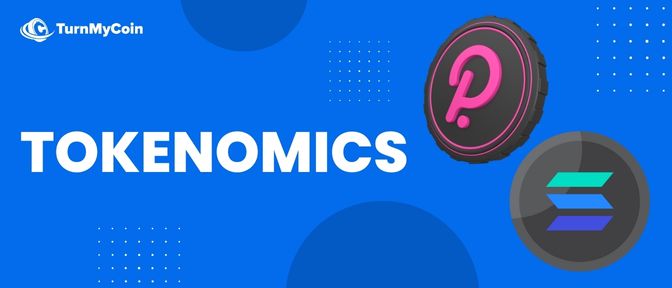
The Solana blockchain’s native coin is called SOL. It is used to pay transaction fees and will soon be necessary under the network’s governance mechanism.
SOL tokens, like Polkadot, have a limitless supply because they are technically programmable. The circulation supply is only 346,159,389 SOL, compared to the existing unfixed maximum supply of 511,616,946 SOL. Since there is no fixed supply, cryptocurrencies experience inflation. Inflation starts out at 8% and declines to just 1.5% after 15 years.
Solana Labs received a portion of the original total supply equal to about 25%. 38% of it was transferred to the Solana Foundation, which is responsible for looking after the communal treasury. Additionally, earlier investors purchased a 35% stake in it through ICOs. For retail investors, only 2% of the total supply is available.
The Polkadot ecosystem’s native cryptocurrency token is called DOT. Even if it is used to cover transaction costs, parachain protocols are not required to do so.
There is no definite maximum supply for Polkadot. At inception, only 10 million DOT tokens were planned to be the network’s maximum supply. But after a vote by the general people, it was increased to 1,103,303,471. Around 987,579,314 DOT are now in circulation.
Investors in the token auction received 50% of the total supply. In addition, 3.4% went to a private sale in 2020, and 5% to one in 2019. Parity Technologies keeps 11.6% of it for potential future fundraising efforts. The Web3 Foundation holds 30% of the entire supply for network development and other purposes.
4. Evidence of Stake & Evidence of History – Solana Blockchain vs Polkadot Blockchain
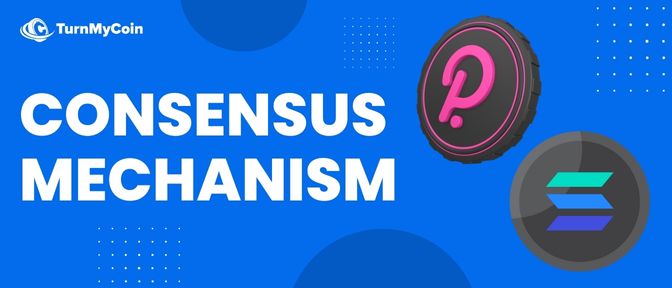
All chain transactions are accurately and quickly verified by Solana using a PoH consensus model. When compared to conventional consensus models, the PoH model is unique.
Using a verifiable control loop, the PoH model arranges all of the transactions into chronological order (VDF). The transactions are distributed to validators for verification after sorting. In contrast to other methods of verification, Solana has tight rules for who can become a validator.
PoH is a good fit for the jigsaw puzzle analogy. In traditional consensus models, validators are given all the parts and asked to put the puzzle together correctly. Validators receive puzzle pieces from Solana’s POH that have numbers on the back.
As the components are already in their proper places, this approach enables fewer individuals to finish the problem in a shorter length of time. The validators must determine whether any components are incorrect or missing. It is quicker and more effective to solve a puzzle or validate transactions using a PoH paradigm.
A Nominated proof-of-stake (NPoS) consensus approach will be used by Polkadot when it is fully operational to verify transactions. Holders of a token can secure their position on the chain using an NPoS paradigm, giving them the opportunity to validate transactions and collect incentives.
The likelihood of receiving a block reward will rise as a result of the pledged pooled funds. The pool will share block rewards with its users as they become available.
The fact that the money is kept off-chain and the pool has a lot of power makes this setup problematic.
5. Solana Blockchain vs Polkadot Blockchain – Which is better?
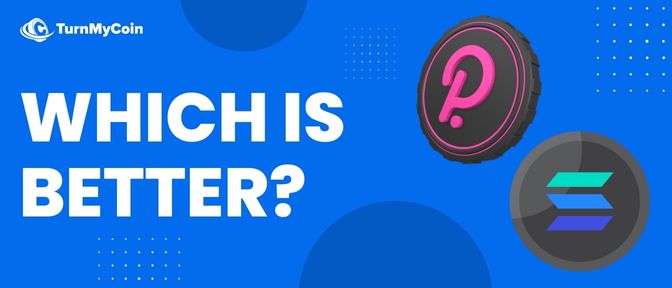
The two blockchains are among the biggest and most well-liked ventures in the sector and have attracted significant institutional interest.
For instance, Solana and FTX Exchange have a partnership to develop Serum. Additionally, the largest NFT market, OpenSea, just enabled trading of Solana-based coins on its platform.
Similarly to that, Enjin announced the debut of Efinity on the Polkadot network towards the end of the 2020. In order to support Moonwell, a Polkadot lending system, Katie Haun, CEO and founder of Web3 venture capital firm Haun Ventures, invested $10 million in it.
Solana is the fastest blockchain network on the market in terms of network speed, with the capacity to handle around 65,000 transactions per second. Polkadot can only validate roughly 1,000 transactions in the same amount of time at present. So as far as speed is concerned Solana is way faster.
However, Polkadot is far superior to Solana in terms of sustainability and interoperability. Polkadot wins the award in this regard.
Conclusion
These two initiatives are so diverse from one another that it is impossible to judge which is better.
Polkadot addresses scalability and interoperability issues using blockchain technology.
Solana strives to be speedy and affordable.
Polkadot and Solana’s purpose is to improve how cryptocurrencies are used to help people.
